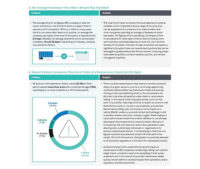A new expo and conference called AEC BuildTech— held in Rosemont, Ill., April 30 to May 2—brought together attendees and suppliers to explore best practices in implementing new technologies in the buildings sector.
“If somebody has learned a lesson, we ought to build as an industry off those lessons,” said Ben Bunge, senior project manager for the Weitz Co. Bunge presented with Kent Hodson, president of PIVOTek and Monty Muller, project manager from the Waldinger Corp., two companies that supplied prefabricated modules to speed construction of a Hilton Hotel in Des Moines, Iowa. Bunge and his team shared lessons about installing prefab bathroom pods from PIVOTek and mechanical/electrical racks and piping from Waldinger. Bunge said one lesson was getting “too aggressive” on what’s preinstalled on the bathroom pods to lift them over the half-inch of adhesive. “We had to go back and ‘undo a couple of items.’ ”
Steve Jones, senior director of research, Dodge Data & Analytics, told attendees at the event sponsored by BNP Media, the parent of ENR, that the industry is “one-third of the way through its digital transformation.” Specifically, he pointed to the results of a 2017 Dodge Smart Market Report “Connecting Design and Construction,” which found that when Building Information Modeling is used by all the key team members in an integrated digital workflow, 61% reported improved schedule performance, 59% reported improved quality, 44% reported reduced material waste, 40% improved company profitability and 39% reduced project cost.
John Jacobs, CIO of JE Dunn, said in a session about contractor-developed tools that contractors need to be able to deep-link with vendor-provided tools to find methods to use their data in the best way for their workflows. In Dunn’s case, this includes proprietary development, deep links with Microsoft, a custom integration with Autodesk design tools and an integration with the ERP system, CMiC.
“If you’re selling a platform, period, it doesn’t really work for us,” he said.






Post a comment to this article
Report Abusive Comment